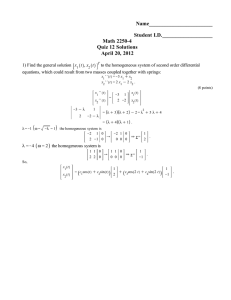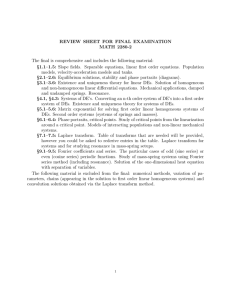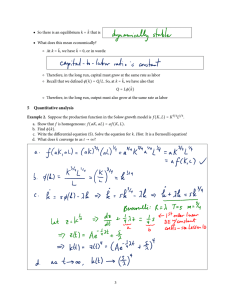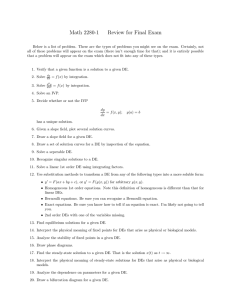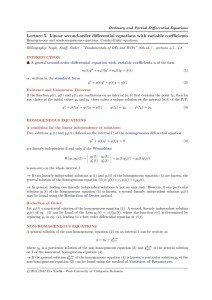Math 2280-1 Review for Exam 1
advertisement
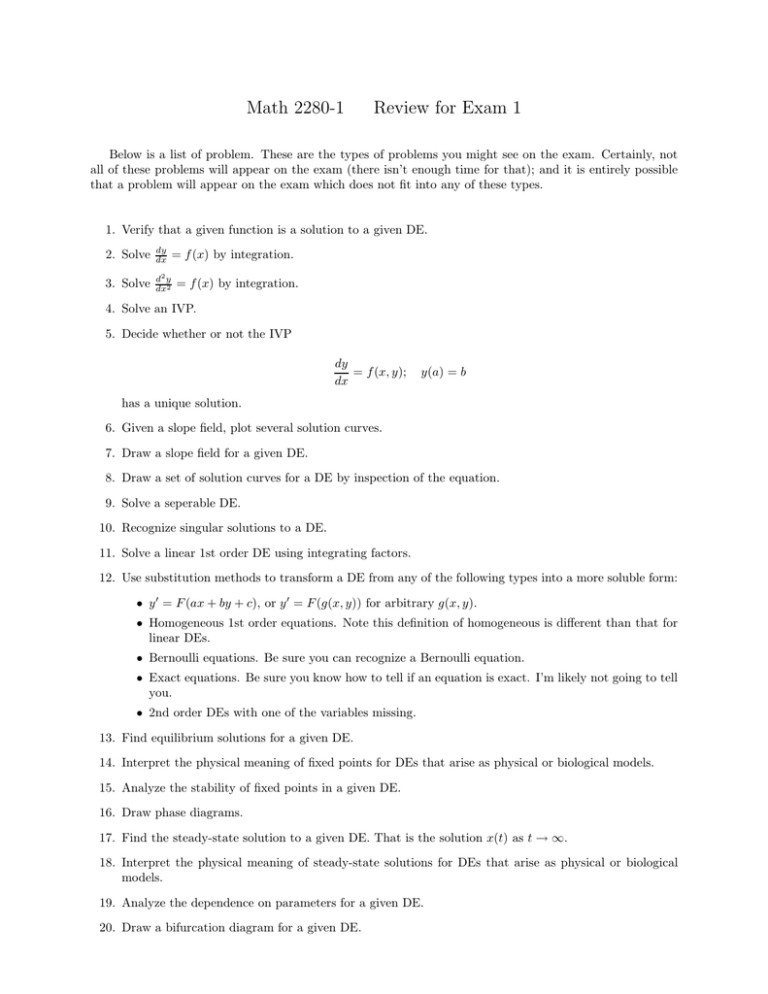
Math 2280-1 Review for Exam 1 Below is a list of problem. These are the types of problems you might see on the exam. Certainly, not all of these problems will appear on the exam (there isn’t enough time for that); and it is entirely possible that a problem will appear on the exam which does not fit into any of these types. 1. Verify that a given function is a solution to a given DE. 2. Solve dy dx 3. Solve d2 y dx2 = f (x) by integration. = f (x) by integration. 4. Solve an IVP. 5. Decide whether or not the IVP dy = f (x, y); dx y(a) = b has a unique solution. 6. Given a slope field, plot several solution curves. 7. Draw a slope field for a given DE. 8. Draw a set of solution curves for a DE by inspection of the equation. 9. Solve a seperable DE. 10. Recognize singular solutions to a DE. 11. Solve a linear 1st order DE using integrating factors. 12. Use substitution methods to transform a DE from any of the following types into a more soluble form: • y ′ = F (ax + by + c), or y ′ = F (g(x, y)) for arbitrary g(x, y). • Homogeneous 1st order equations. Note this definition of homogeneous is different than that for linear DEs. • Bernoulli equations. Be sure you can recognize a Bernoulli equation. • Exact equations. Be sure you know how to tell if an equation is exact. I’m likely not going to tell you. • 2nd order DEs with one of the variables missing. 13. Find equilibrium solutions for a given DE. 14. Interpret the physical meaning of fixed points for DEs that arise as physical or biological models. 15. Analyze the stability of fixed points in a given DE. 16. Draw phase diagrams. 17. Find the steady-state solution to a given DE. That is the solution x(t) as t → ∞. 18. Interpret the physical meaning of steady-state solutions for DEs that arise as physical or biological models. 19. Analyze the dependence on parameters for a given DE. 20. Draw a bifurcation diagram for a given DE. 21. Employ any of the following physical or biological models: • Toricelli’s Law. • Newton’s Law of Cooling. • Exponential Growth/Decay. • Logistic Growth. • Doomsday. • Generalized Population Growth. • Drag forces proportional to a power p of velocity. • Variable Gravitational Acceleration, Newton’s Law of Gravity. • Spring, Mass, Dashpot system. 22. Employ the Principle of Superposition for homogenous linear equations. 23. Solve a 2nd order IVP. 24. Determine whether or not two or more functions are linearly independent. 25. Use the Wronskian of two or more solutions to a DE to determine if they form a basis for the solution space. 26. Find the general solution to a homogeneous linear equation. 27. Using a particular solution yp to a nonhomogeneous linear nth order DE, and n linearly independent solutions, y1 , . . . , yn , to its associated homogeneous equation, find the general solution to the nonhomogenous equation. 28. Use the characteristic equation to find the general solution to a linear DE with constant coefficients. 29. Some light proofs. 30. Some written explanations. 31. Definitions. Don’t spend too much time studying these, there won’t be many. 32. True or False problems. You will need to support your answer.

